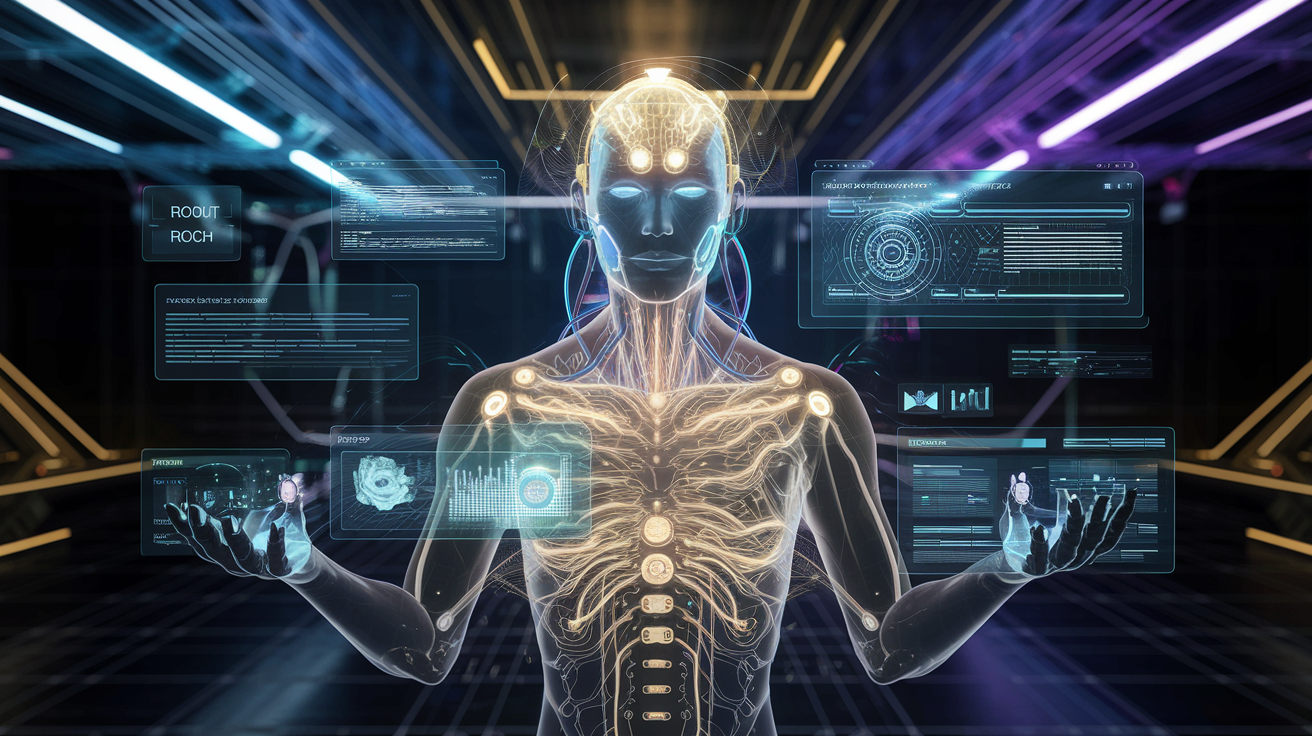Imagine a doctor looking at an X-ray while your voice gives a quick diagnosis. Or a teacher adjusting a lesson based on a student’s face. This isn’t fantasy—it’s our future with multimodal AI.
Two years ago, GPT-4 combined text and images. Now, Gemini and OpenAI’s Sora mix video, audio, and voice. I’ve seen it grow, and it’s amazing to see machines understand like we do.
Think about making a video from just a sentence or an AI getting your tone for better support. By 2025, AI will predict and adapt, making human and machine intelligence blend. Try it today with $300 free credits on Google Cloud’s Vertex AI.
This isn’t just tech—it’s changing how we create, learn, and connect. Let’s see how multimodal AI is changing our world, from health to creativity. What’s possible when machines see, hear, and learn like us?
Introduction to Multimodal AI
Imagine asking an AI to analyze a photo while it listens to your voice. That’s what ai with multiple modalities can do. It combines text, audio, video, and images into one system. This technology is used in tools that create art from words or find problems in medical scans.
What is Multimodal AI?
At its heart, multimodal AI mixes different data types to tackle tough tasks. It sees text, sound, and images as connected pieces. Carnegie Mellon research shows it works by handling varied data, linking them, and analyzing their interactions.
This approach leads to cool stuff like chatbots that understand more than just words. Or apps that diagnose issues by looking at sensor data and visuals.
Key Features and Capabilities
- Unified Data Processing: It mixes text, audio, and images into one whole.
- Contextual Intelligence: It looks at how different types of data relate to each other. For example, matching a voice command with what it sees.
- Adaptive Problem-Solving: It learns from different data types to get better at tasks. Like predicting when equipment might fail by listening and watching.
Models like GPT-4o and DALL-E 3 show what’s possible. By 2032, this tech could be worth over $1.2 billion, growing 30% every year. It’s changing industries like retail and self-driving cars. Its ability to create text, code, and visuals from mixed inputs is opening up new ways to be creative and efficient.
Innovative Capabilities of Multimodal AI
Imagine a system that can turn a photo into a recipe or speak words into code. Multimodal AI technologies are making this a reality today. These systems can handle text, images, audio, and video, creating outputs that were once thought of as science fiction.
For example, healthcare teams can now use X-rays and patient histories to predict diseases quicker. Retail apps can analyze customer feedback videos to suggest products in real time.
- Healthcare: Detects tumors by linking scans to electronic health records
- Retail: Creates personalized ads using social media posts and purchase history
- Education: Converts lecture videos into interactive study guides
These systems have three main parts: input modules to gather data, fusion modules to combine it, and output modules to create results. Vertex AI’s platform even offers tools to build custom solutions with top-level security. And with $300 in free credits, developers can test multimodal models without risk.
The future is already here. A single AI system can draft an email, design a logo, and suggest music all at once.
Integrating AI with Multiple Modalities
Seamless integration of multimodal AI needs a good plan. It’s about matching tech strategies with business goals. Here’s how to use the benefits of multimodal ai wisely and avoid mistakes.
Tips for Seamless Integration
- Start by setting clear goals. Figure out which data types (text, images, audio) fit your industry best.
- Try Google Cloud’s Vertex AI with their $300 free credits. It’s a safe way to test multimodal models.
- Use self-supervised learning to work with data without labels. It can cut costs by 40–60%.
Real-World Case Studies
In healthcare, the WHO now classifies gliomas by combining scans with genomic data. This has reduced diagnostic errors by 22%. Retail brands use customer reviews and product images to predict trends 3x faster. Educational platforms like Coursera have seen a 18% boost in retention by using multimodal quizzes.
Vertex AI’s HAIM framework tested 14,324 models on 34,537 patient records. It showed multimodal systems beat single-source methods by 6–33% in tasks like predicting mortality. These benefits of multimodal ai are real: 6485 patient outcomes got better after hospitals started using multimodal analytics.
Revolutionizing Content Generation
Multimodal AI applications are changing how we create. Just type a prompt, and you get a video, song, and marketing copy. OpenAI’s Sora turns text into videos, blending tech with storytelling. This is a game-changer for marketing and education.
These systems can handle different formats easily. Here’s what they can make:
- Text-based video scripts
- Custom audio tracks from descriptions
- Interactive educational modules with images and code snippets
The AI media market is growing fast, expected to reach $121.99 billion by 2032. This shows how much people want tools that mix visuals, sound, and text.
In customer service, 65% of leaders say AI personalization boosts satisfaction. Imagine a chatbot that writes emails, designs infographics, and adds music. For creators, this means quicker work and more engaging content. Teachers can make interactive lessons with quizzes and animations.
New users can try these tools with Google Cloud’s $300 free credits. Whether making website code or designing social media, multimodal AI makes things easier. With 65% of people remembering visuals better than text, this tech is key.
The Power of multimodal artificial intelligence
Multimodal AI systems combine text, images, audio, and video for seamless interactions. They redefine how technology serves us. For example, in healthcare, AI can spot patterns in X-rays and patient histories that doctors might miss.

Enhancing User Experience with Diverse Media
Imagine a doctor looking at an MRI scan while AI checks the patient’s history and symptoms. Systems like Google’s DeepMind do this, linking imaging data with clinical notes for diagnoses. Here’s how:
- Preprocessing: Audio notes are transcribed, X-rays analyzed via CNNs, and text histories parsed for keywords.
- Alignment: Temporal alignment ensures timing matches between, say, a heart rate recording and an ECG image.
- Decision-making: Attention mechanisms zero in on critical data points, like a suspicious scan region linked to chronic symptoms.
These steps turn scattered data into clear insights. They reduce diagnostic delays and improve accuracy.
Leveraging Free Credits for Experimentation
You don’t need a PhD to explore multimodal AI systems. Vertex AI offers $300 in free credits for testing models. You can try converting voice memos into marketing scripts or blending social media posts with images for ads. Here’s how:
- Sign up for Vertex AI and claim credits via the Google Cloud portal.
- Experiment with pre-trained models like PaLM 2 or code-specific tools.
- Adjust parameters to see how text and visuals interact in your projects.
Every interaction makes your workflows smarter over time.
AI with Multiple Modalities Unleashed
Seeing multimodal ai integration in action is like opening a new world of tech. Imagine an AI that looks at a customer’s photo and review at the same time. It then gives them personalized suggestions. This is what happens when we mix sight and text.
This change is huge for e-commerce sites. Now, visual and text data work together to make shopping better for everyone.
- Healthcare: Merging patient scans with medical records for faster, accurate diagnoses
- Entertainment: Crafting interactive narratives that blend text, audio, and visuals
- Virtual reality: Enabling gesture-controlled interfaces for immersive gaming
There are challenges, like data bias and understanding how it works. But the progress is clear. Tools like Vertex AI let developers play with code, images, and audio easily. New users can start today with $300 in free credits to try multimodal ai integration themselves.
I’m looking forward to the future. Imagine an AI that gets a video as well as we do. That’s what systems that can handle many types of data promise.
As more areas use these models, we’ll see more creativity and efficiency. It’s not just about mixing data types. It’s about what AI can now do.
Exploring Multimodal AI Applications
Multimodal AI is changing industries by combining text, images, audio, and video. Vertex AI’s platform helps developers make interactive tools. These range from fitness apps to real-time translators. New users get $300 in free credits to try these features.
Qualcomm’s tech analyzes videos in real-time, guiding users through yoga. GPT-4V can turn handwritten notes into digital text and even code. In healthcare, it mixes X-rays with patient data to suggest treatments.
Generating Text, Code, Video, Audio, and Images
Imagine turning voice commands into marketing videos or translating designs into apps. Here’s how industries use these features:
- Healthcare: AI analyzes MRI scans and patient records to suggest personalized treatment plans.
- Retail: Shoppers can search products using photos and text, getting instant recommendations.
- Education: Interactive tutorials mix video lectures with quizzes, boosting engagement.
Maximizing Vertex AI Capabilities
Vertex AI’s tools let users build custom solutions with multimodal models. It supports code generation, audio responses, and image-based design. Start by testing free credits to see how it can improve workflows or user interactions.
While data quality is a challenge, Vertex’s tools make deployment easier. By blending modalities, these systems offer an enhanced user experience with multimodal ai. This drives innovation in customer support and creative design.
Future Prospects of Multimodal AI Technologies
The future of multimodal artificial intelligence is set to change many industries. It will use text, audio, video, and IoT data. By 2027, it’s expected to grow from 1% to 40%.
Meta’s Ray Ban smart glasses AI and Apple’s MM1 model are leading the way. Google and Microsoft are also making big strides. They’re creating tools that can do everything from coding to visual analysis.
- Meta: Testing GPT-4V rivals in wearable tech (2024)
- Apple: MM1 enhances Siri with multimodal context (2024)
- Google: Gemini processes text, audio, and images (2023)
- Microsoft: Kosmos-1 bridges visual and language tasks (2023)
AI is getting better at handling complex tasks. Imagine healthcare systems using scans and notes to diagnose illnesses. Or education platforms mixing video lectures with quizzes.
These tools could even predict equipment failures in manufacturing. It’s all thanks to advancements like transformer fusion and attention mechanisms.

I think the future of multimodal artificial intelligence depends on ethics. As AI uses more data types, like IoT sensors and code, it’s key to focus on safety and transparency. In the next five years, these technologies will be as important as smartphones, changing how we use digital tools.
Getting Started with Google Cloud’s Multimodal Models
Want to try out multimodal AI without spending a lot? Google Cloud gives new users $300 in free credits to try out Vertex AI and its tools. Here’s how to get started and begin your first project.
How to Claim Your $300 Free Credits
First, go to Google Cloud’s website and make an account. Follow these steps to get your credits:
- Sign up with your email and verify your info.
- Choose the “Free Tier” option to get the $300 credit.
- Check if you meet the eligibility and agree to use AI responsibly.
Step-by-Step Guide to Implementation
After you get your credits, start using Vertex AI with these steps:
Explore foundational tools:
- Use the Gemini API for text and images.
- Try MedLM for health questions or Imagen for visuals.
Customize your workflow:
- Adjust models for specific needs.
- Use RAG or function calls for better context.
For help, try Gemini 2.0’s screen-sharing. It’s safe, so you can be creative without worrying about ethics.
Vertex AI’s toolkit fits your needs, whether coding, designing, or prototyping. Start small, try new things, and grow as you go—all within your $300 credit.
Conclusion
Multimodal AI is changing how technology affects our lives. It combines text, images, audio, and sensor data. This lets machines understand context in new ways.
This technology leads to breakthroughs like real-time translations and advanced healthcare diagnostics. Imagine AI analyzing a patient’s symptoms and scans to suggest treatments. This is what cross-modal learning can do.
Healthcare, retail, and autonomous systems are already seeing benefits. For example, multimodal models help in mental health assessments by looking at voice tone and facial expressions. Tools like Google Cloud’s Vertex AI make these technologies available, with free credits for trying them out.
Workshops like those from the Silicon Valley Innovation Center help businesses use these tools responsibly. They focus on ethical use and reducing bias.
Despite challenges like data privacy and integration, progress keeps moving forward. Future goals include making multimodal AI easier to use and more transparent. Developers and entrepreneurs can start using these tools today to create personalized healthcare solutions or immersive entertainment.
This technology is no longer just for big tech companies. It can be used to optimize supply chains and improve security. The next decade will see AI becoming a key partner in creativity and solving problems.
The question is not if, but how you’ll use these tools to shape the future.
FAQ
What is multimodal AI?
Multimodal AI is a type of artificial intelligence. It can handle and understand different kinds of data at the same time. This includes text, images, audio, and video. It works like our brains do, using many sources of information to give us a full picture.
What are some benefits of multimodal AI?
Multimodal AI makes things better in many ways. It gives users a better experience and makes data analysis more accurate. It can also create content in various formats, making it more complete and meaningful.
How are multimodal AI technologies being used across industries?
Multimodal AI is used in many fields like marketing, healthcare, education, and entertainment. It helps make content more engaging and dynamic. This way, businesses can talk to their audience in a more effective and fun way.
Can multimodal AI enhance user experiences?
Yes, it definitely can! By using different types of media, multimodal AI makes things more fun and easy to use. It helps people connect better with what they’re seeing or hearing, making them happier.
What are practical strategies for integrating multimodal AI systems?
To integrate multimodal AI, first figure out what data types you need. Make sure the data flows smoothly between systems. Use frameworks that support mixing different media types. Look at successful examples to see how it’s done.
How can I get started with multimodal AI using Google Cloud?
Start by getting your $300 free credits from Google Cloud. This lets you try out multimodal AI models without spending money. Follow the easy steps they provide to start using these technologies.
What does the future hold for multimodal AI?
The future of multimodal AI is exciting. With more research and development, it will get even better. We can expect more use across industries, more ethical AI, and closer to how our brains work.





